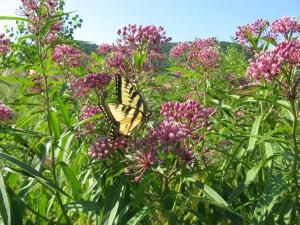What's Working for Conservation
Keys to Project Success
2020 Information
- The most effective leaders are those who see the bigger picture and look to the future.
- One most important change we can make to support an ecological vision is to find a way to educate local to state leaders on ecologically sound practices.
- We need to change the conversation at all levels. Creating a positive vibe around “biodiversity” “ecology” “conservation” “habitat”. Make it the “norm”.
- Create a land ethic (in Aldo Leopold’s words).
- Dispel the current ingrained social myths around turf, pesticides, insects.
In summary, our biggest challenge is changing the narrative! ( Laurie Schneider, Executive Director, Pollinator Friendly Alliance)
2016 Information
The following list summarizes "keys to restoration success" that have been compiled from a variety of ecological restoration professionals from agencies, non-profit organizations, consulting firms and contractors. The statements with an * were noted by one or more professionals in a survey asking what they thought were the most important considerations.
Planning and Documentation Topics:
- Ensuring that project support will be stable (funding, partner commitment, etc.) *
- Collecting sufficient site assessment information*
- Assess site stressors including any chemicals/contaminants that may hinder restoration
- Understanding the limitations and opportunities of project sites*
- Developing a plan (and contingency plan) and following it*
- Planning and using well established/proven practices*
- Setting SMART goals (Specific, Measurable, Achievable, Reasonable, Time-bound)
- Using performance standards so everyone involved is clear how to measure success
- Expect the unexpected (drought, flooding, invasive species) and conduct contingency planning*
- Using research studies to guide restoration planning
- Addressing the cause of invasive species, and prioritizing species to target*
- Collaborating with many partners to get different viewpoints
- Keeping good project records
Implementation Topics:
- Hiring experienced/qualified contractors*
- Considering contractors as key project partners
- Capitalizing on the strengths of team members
- Involve passionate volunteers
- Ensuring clear and frequent communication between project partners
- Maximizing use of native seedbanks
- Using high quality seed and plants*
- Not fighting the momentum of an altered plant community unless goals can be attained*
- Allowing time for soil health to improve and natural succession to take place*
- Not rushing a project, such as seeding before site preparation is complete*
- Not assuming that initial success will mean long-term success
- Fighting the temptation to rely too heavily on herbicides
- Focus on projects where there can be long-term management
- Find innovative methods of long-term management
- Frequent monitoring and adapt planning based on monitoring*
- Learning from each other's mistakes and successes*
- Mentor the next generation of restoration professionals
- Celebrate project successes

